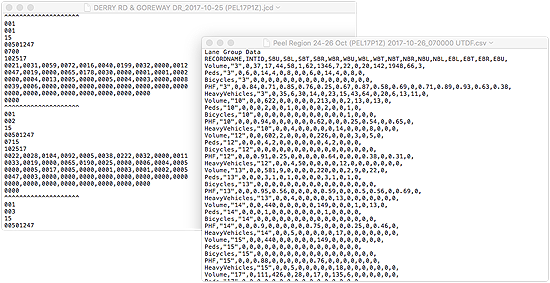Spectrum AC
Manage All Your Traffic Data Assets In One Place
Spectrum AC is an advanced web based portal that allows you to manage all of your traffic data assets in one convenient location.
It was designed with the practitioner in mind, so efficiency is at its core. Common, repetitive and time consuming tasks like
archiving and retrieving historic data, creating engineering ready spreadsheet formats, and exporting data into traffic models is made
easy with Spectrum AC.
Google Mapview

Every count conducted by Spectrum is geo-tagged. Locating historic data is as simple as a Google map search directly from within AC. It's private, and it's secure so
only your organization can access your data.
Your entire catalogue can be viewed
at once in mapview mode, or you can perform a geo-lookup based on street name, address or city. Data is clustered so browsing is fast and easy.
How many times have you heard this at the office:
"does anyone know if we have any recent counts here?"
Log in to AC, click on the location and download all historic data at that site in a convenient zip file. No more company wide emails or wasteful network folder searches..it's all right there.Engineer Ready Reports

"Engineer Ready" to Spectrum means that you shouldn't be wasting time calculating things that should already be calculated for you. That's why all of our reports
automatically calculate heavy percentages, peak hour factors (by intersection, approach and turn) and peak hour periods.
Our spreadsheet reports are in native Excel 95 compatable format, so they will open on any version of Excel. Original data is layed out in worksheets by class,
and peak hour sheets are generated automatically as separate worksheets. Every engineering calculation is documented via formula, such as peak hour factor and heavy percentage.
Our pdf reports are "report ready". Headings are labelled with your company name and address, date, study location and field tech responsible for the
count. Pages are numbered and labelled by project ID in the footer. Peak hour sheets include approach totals, phf by movement and approach, heavy percentage by movement and approach as well as detailed classification break downs.
Weather is automatically included into each peak hour report based on the OpenWeather API.
Advanced Export

Traffic Engineering Software (TES)
TES is used by a wide range of public sector organizations in Ontario for the archiving and retrieval of street level traffic data including TMC's, ATR's, accident records and much more. Keeping TES up to date in a timely and efficient fashion is a priority for municipalities using TES. Spectrum AC ensures the easy transfer of data into TES by providing a .jcd export function. TES ready files can be extracted by location, or by batch mode. Work order ID's are automatically included in every TES file from our G.I.S. location database so that files are ready to import into TES with no extra work.Universal Traffic Data Format (UTDF)
UTDF is a file format used by Trafficware's Synchro software to automatically import intersection volumes, among other things. By using UTDF to import data into your Synchro models, you save time and avoid error prone manual data entry. In addition to vehicular volumes, every UTDF file generated by Spectrum AC includes heavy percentages, peak hour factors, pedestrian volumes and bicycle volumes separated on the road. You can export UTDF files location by location, oreven generate an entire UTDF file by network. Network UTDF files can be customized to provide peak hour volumes by location, or a single forced network peak. Don't know what the network peak is? No problem, our network map view will help you identify it automatically.Cloud Video

Spectrum AC provides quick and easy access to videos acquired as part of the data collection process. TMC videos can be loaded
directly in Spectrum AC for review in a web based video player. Videos are stored on the cloud for a two year period after which they are automatically deleted. Additional storage time can be purchased online for a minimum fee.
Videos are encoded in h264 mpeg format at 720x480 resolution (475 kb/s, 30 fps). Videos can be used for additional post-processing analysis including:
- Saturation Flow Study
- Turning Delay Study
- Queue Length Study
- Signal Timing Review